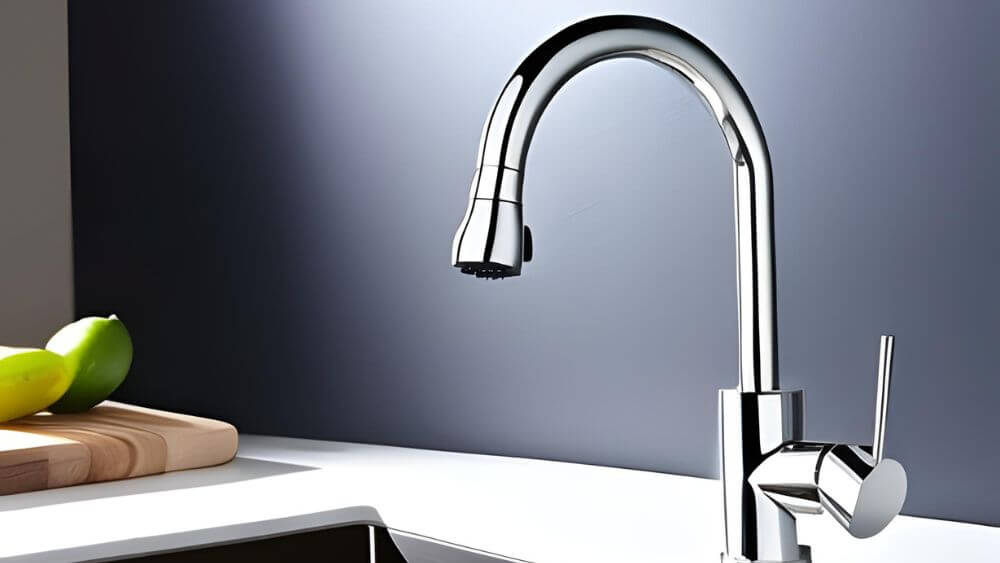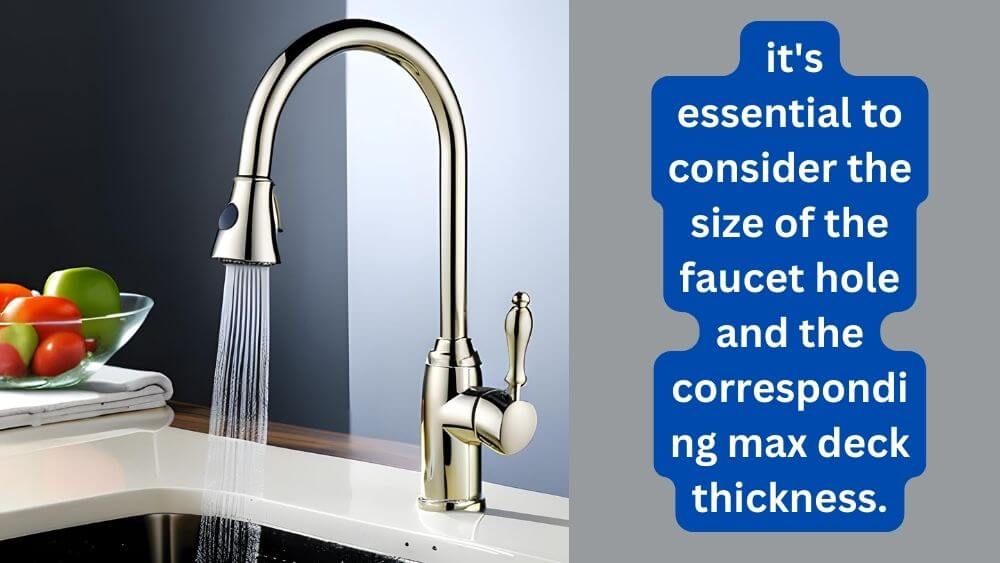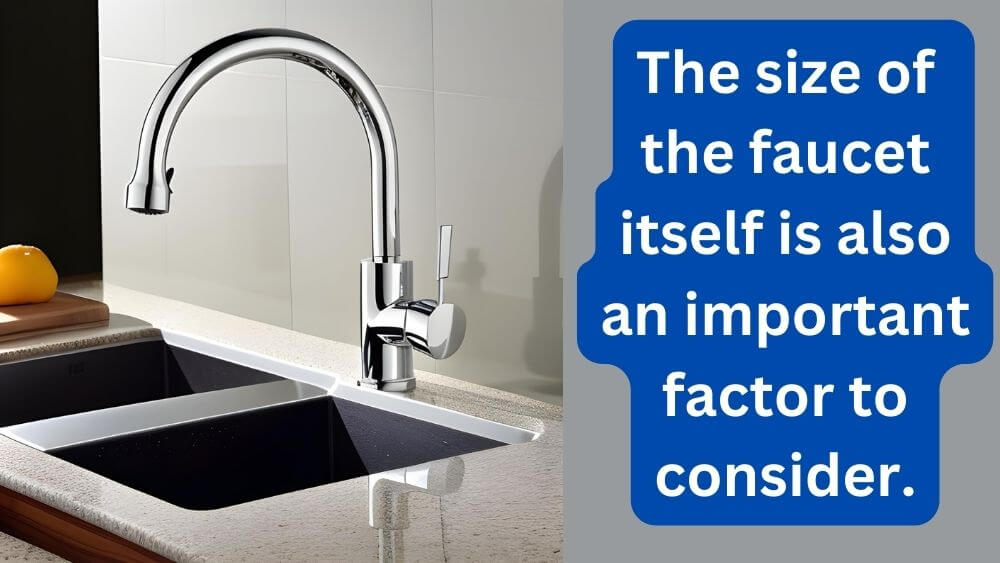
A kitchen faucet is necessary for doing dishes, washing hands, and distributing water, but it also serves as a decorative element in many kitchens. If you are upgrading your kitchen faucet or installing a new one, you should know about the size of the kitchen faucet hole size, spacing, faucet mounting, etc. Now, what is this faucet hole size? Somedays ago, I was in a deep ocean while installing a new faucet at my new home then I decided to find out the hooks and nooks of this kitchen faucet hole size. After getting clear, I thought of sharing them with you.
So today, we will talk about the various hole sizes and the standard kitchen faucet hole size. The foremost thing you should consider before buying a new faucet is if it matches the spacing of holes in your kitchen sink.
Standard kitchen faucet hole size
The standard faucet hole size for kitchens and bathrooms is 1 3/8″ (1.375 inches or 34.925 mm) in diameter, but this may vary depending on the make and model. It is also important to consider the maximum deck thickness of the faucet to ensure a proper fit. Measuring the faucet hole size can be done with a slide caliper, and standard faucet hole spacing can be single-hole, centerset, minispread, widespread, vessel, or wall-mounted. If a faucet hole is too small for the purchased faucet, the hole can be enlarged, or an exchange can be made. Escutcheon plates can be used to cover extra sinkholes.
Though there is no fixed size for a kitchen faucet hole, it is hard to say the standard size for a kitchen faucet hole. Because there are various types of kitchen faucets, actual kitchen faucet holes do not have any uniform size.
The standard size of kitchen faucet holes depends on the type of faucet you want to install. So it’s better to know your faucet size first; then, you can start drilling according to its size and get a perfect installation. But what if it is pre-holed and you bought the faucet later? Then the conventional size for the faucet holes can be considered the best size, typically one and ⅜ inches wide. However, some faucets may need holes that are 1.½ inches wide.
A good faucet often only requires one hole; however, kitchen faucets, used with a plate or bowl of any size, require three holes total. Your faucet’s size will determine the hole’s size.
Each hole needs to be spaced apart by roughly 4 inches for a center-set faucet, and you must space the holes 6 to 8 inches apart for a center widespread faucet. The opening in the middle for the water escape piping and the knob controls must be the same standard size.
You must dig many holes, and each must be precisely 1-1/8 inches deep to ensure that the faucet connector is properly positioned if you wish for your faucet to be more flexible or have additional features.
Is there a minimum quantity of holes needed to install a faucet?
The type of faucet you choose determines the price want to put in and how many holes are needed for it. A faucet normally has one to four holes, the fourth of which is used to attach a soap dispenser. Bridge-style faucets need two holes. Standard double-handle faucets have three holes, but single-handle faucets frequently need one hole. Generally, a 4 inches distance is needed between the handles, or between the spouts, and for any other kitchen fixtures, you will need a space of 8 inches.
Side sprayers, Soap dispensers, Water purifiers, and Hot water dispensers are some other items for which you may need to drill additional holes. Although the distance between accessories and faucets is largely optional, keeping them apart is crucial; otherwise, you will lose your working space.
Suitable countertop hole size for a faucet
If there is no hole installed in your kitchen sink or the ones installed are big or small for your faucet, you might need to drill a hole in your countertop to install the faucet.
If your kitchen faucet is conventional and does not contain any air gap, then the faucet will need a hole of at least 7/16 inches in diameter.
Sometimes the escutcheon plates, available with your faucet, must be customized as they have some issues matching with 1.5-inch holes. But you can buy larger plates too though they will make your kitchen look detracted. So the result is that the standard faucet can fit in holes between 1.25 and 1.5 inches in diameter.
But you must drill a larger one if your existing hole is smaller; otherwise, you must search in the bush to find an escutcheon plate suitable to fit your existing sinkhole.
Kitchen Faucet Hole Spacing
Are you frustrated trying to fit your kitchen faucet into a hole that isn’t the right size? The standard hole size for kitchen faucets is 1 1/2 inches, but some newly built homes have 34-inch holes. You might have trouble fitting the needle through the hole if it’s too small a tap. You won’t get the full force of water to fill large pots or pans. Fitting a kitchen faucet into a small hole can be difficult. But that’s where specialized adapters come in. These adapters are designed to fit into smaller holes, giving you the full function and flow of a regular kitchen faucet. They also come in different sizes, so you can find one to fit your needs.
The adapters are durable and have various features, including easy installation, long-lasting performance, and leak-proof protection. And they’re affordable too. So, instead of replacing your entire faucet, you can purchase an adapter and be done with it. Plus, you’ll save time and money by hiring a plumber. So, don’t let a smaller hole size frustrate you. If your kitchen faucet does not have the full function or flow you need, you need to purchase an adapter.

How to measure a faucet hole size?
When replacing your existing faucet with a new one, it is essential to measure the hole size. Getting the right measurement can be challenging, especially if you aren’t sure what to look for. Accurate measurements must be taken to ensure that the replacement faucet fits perfectly and functions properly.
To measure faucet hole size, follow these steps:
Use a slide caliper: The most accurate way to measure the inside diameter of the faucet hole is to use a slide caliper. The measuring accuracy for this type of tool ranges from +/- 0.001″ to +/- 0.0015″ (+/- 0.02 mm to +/- 0.04 mm), providing accurate results.
Place the inside jaw of the caliper against the inside of the faucet hole: Position the inside jaw of the slide caliper against the inside.
Slide the scale outward until it reaches the maximum distance: Move it outward until it reaches the maximum distance inside the hole.
Slide the caliper out and read the measurement: Slide the caliper out of the hole and read the measurement indicated on the scale. This reading is the diameter of the faucet hole.
Also, if you do not have a slide caliper, you can measure the diameter of the hole using a ruler or tape measure. Slide calipers are more accurate than these tools but may not provide accurate measurements.
You can choose from several faucet hole sizes. The most common sizes are 1 3/8 inches, 1 1/2 inches, and 1 3/4 inches. Each size has its advantages and disadvantages, depending on the type of faucet and sink you have.
To help you make an informed decision, let’s compare the three most common faucet hole sizes.
| Faucet Hole Size | Pros | Cons |
| 1 3/8 inches |
– Suitable for most single-handle faucets – Takes up less counter space |
– May not accommodate larger or more complex faucets |
| 1 1/2 inches |
– Fits most standard double-handle faucets – Allows for some flexibility in faucet choices |
– Takes up slightly more counter space than 1 3/8 inch hole |
| 1 3/4 inches |
– Accommodates larger or more complex faucets – Allows for more flexibility in faucet choices |
– Takes up the most counter space |
As you can see from the table, the 1 3/8 inch hole size is best suited for smaller or simpler faucets, while the 1 3/4 inch hole size is ideal for larger or more complex faucets. The 1 1/2 inch size falls somewhere in between and offers some flexibility in faucet choices while still being relatively space-efficient.
It’s worth noting that the size of your sink and the placement of existing holes may also play a role in your decision. It’s always a good idea to measure and consult with a professional before making any modifications to your sink or countertop.
When it comes to selecting the right faucet for your sink, it’s important to consider the size of the faucet hole. Different brands and models may have varying hole sizes, which can impact the installation process and the overall look of the sink. In this discussion, we’ll compare a few common faucet hole sizes and their corresponding max deck thickness.
The table below shows the brand, part number, hole size, and max deck thickness for each faucet.
| Brand | Part Number | Hole Size (inches) | Max Deck Thickness (inches) |
| Delta | 3559-BLMPU | 1.375 | 2.5 |
| Kohler | K-596-VS | 1.375 | 2.5 |
| Moen | 7594SRS | 1.5 | 2 |
| Pfister | GT529-WHS | 1.375 | 2.5 |
As you can see, three out of the four faucets have a hole size of 1.375 inches, while the Moen faucet has a slightly larger hole size of 1.5 inches. The max deck thickness ranges from 2 to 2.5 inches for all four models.
It’s important to note that while these sizes are common, they may not apply to all faucets. It’s always best to consult the manufacturer’s specifications and guidelines to ensure proper installation. Additionally, it’s crucial to measure the existing faucet hole in your sink before purchasing a new faucet to ensure compatibility.
In conclusion, when choosing a new faucet, it’s essential to consider the size of the faucet hole and the corresponding max deck thickness. This will help ensure a smooth installation process and a cohesive look for your sink and faucet combination.

Standard Faucet Hole Spacing
Successful faucet installation isn’t just about picking the right style: it’s also about spacing the holes correctly! Whether you’re dealing with a single hole, a double hole, or a triple hole setup, the distance between the holes depends on the size and style of your sink. Therefore, choose wisely! It doesn’t matter what sink style you have; correctly spacing the holes is essential to ensure the faucet is properly installed. Single-hole setups require more space than double or triple-hole setups, but with adequate planning, you can get the appropriate fit for any sink style. By measuring the distance between the holes, you can ensure that the faucet is properly centered and that you have enough room to use it comfortably. Once everything is right, you’re ready to start the installation. With patience and a sharp eye, you’ll quickly have the proper faucet setup!
Single Faucet Hole Size
If you’re looking to replace or install a kitchen faucet in your home, paying attention to the details is key. The typical hole size for faucets is 1 3/8 inches, or 34.925 millimeters, as reported by most producers. In addition to the above, you must be aware of any other specifications you should consider before purchasing.
Centerset Faucet Holes
Instantly upgrade the look of your one- to three-hole sinks and countertops with this sleek and practical combination faucet design. This popular design fits into center-set faucets, featuring a single deck plate that combines the handles and spout. This design requires holes with 4″ centers between the left and right holes for optimal performance.
Measuring a sink size
First, measure the depth from the sink’s brim where it touches the countertop up to its approximate depth. Then to find the approximate width, you need to measure the sink’s outer surface from front to back, and using the same procedure of measuring width, you can measure the approximate length. But now you will have to measure from the left to right surface of the sink along the furthest borders of the sink.
Measuring the faucet size
To measure the size of the faucet, you will have to measure the distance between the water supply pipes under the tap for a single-handle faucet. If your faucet has two handles, then you must measure the distance between the centers of each handle’s length and the faucet’s actual center.
Equipment for measuring
Using a sliding caliper could be a solution for all of these measurements. It will help you to measure the hole’s interior diameter precisely.
Put the inner jaw of the slide caliper next to the faucet hole’s interior first, then Slide the scale once more until the maximum distance is reached. The reading, which shows the diameter of the faucet’s hole size, will be the final size.
Hiding Additional Sink Holes
You may conceal the extra holes in your sink using the escutcheon plates. These plates will also act as the connection between the internal diameter of the orifice and the outer diameter of the pipe. You can also cover the extra single-hole cover plates if the extra holes are too far apart from one another.
Wall-mounted
Give your space a futuristic feel with wall-mounted automatic faucets! These innovative fixtures provide a sleek, modern look and are popular for bathrooms and kitchens in educational, healthcare, and commercial settings. All the necessary supply pipes are conveniently tucked behind the wall yet offer full functionality.
Placement of Faucet
The faucet’s usual location is just behind the sink, in the middle of the sides. The setback distance is commonly 2 to 4 inches depending on the product. Make a mark for each hole on the countertop half as far from the center of the sink as the distance between the tailpieces. When installing a three-hole faucet, locate the other two holes’ locations and mark them with a ruler to align them.
Remember that the faucet connectors beneath the countertop must clear the sink’s base. It is frequently impossible to install the faucet any closer than the recommended setback distance when the sink is square or rectangular due to a lack of clearance.
Centered placement of the faucet
You may need to place your faucet in some unusual sink space.
First is if there is not enough space for the backsplash of the faucet or if there is anything under the sink in addition. In this case, you might need to place your faucet in another space second if your sink is not in regular shape. A centered placement may look odd if your sink is not oval or rectangular like all the common sinks.
Thirdly, If the bathroom or kitchen has an odd design, the positioning of the faucet will work better to match it. And you might also want To be able to turn the faucet and fill a pot resting on the countertop, and you might wish to install the faucet on the side of the sink rather than the rear.
Can I drill my faucet hole?
You can drill your faucet hole with the right tools and know-how. You’ll need a power drill, metal or wood drill bits, and some wood or masonry screws to secure the faucet in place. Start by selecting the correct drill bit size for your faucet’s mounting bracket and ensure each drill point is level with the countertop. If done correctly, this could save you much money instead of hiring an experienced plumber. However, it is essential to be careful when drilling on any surface since mistakes can lead to significant problems.
Factors to Consider When Choosing Kitchen Faucet Hole Size
When choosing a kitchen faucet, it’s important to consider the hole size required in your sink or countertop. Selecting the right size hole ensures your faucet fits properly and functions correctly. Here are some factors to consider when choosing a kitchen faucet hole size:
Size of a sink – The size of your sink will play a role in determining the size of the faucet hole. Larger sinks may require a larger faucet and, therefore, a larger hole.
Size of a faucet – The size of the faucet itself is also an important factor to consider. A larger faucet may require a larger hole in the sink or countertop.
Style and design preference – Your personal style and design preferences will also play a role in choosing the right kitchen faucet hole size. The type of faucet and the number of holes required will depend on your desired design and functionality.
Several holes needed – Consider the number of holes needed for the faucet and any additional accessories, such as a soap dispenser or side spray. This will determine the configuration of the holes required in the sink or countertop.
Manufacturer’s specifications – Always check the specifications before purchasing a faucet to ensure it fits your sink and the required hole size.
Considering these factors, you can select the right kitchen faucet hole size and ensure a proper fit and functionality for your sink and faucet.
Unusual placements of the faucet
It’s not a big problem to locate your faucet anywhere around the sink if you maintain some conditions, like overhanging the spout completely over the sink. Also, be careful about anything preventing the handles from fully working. In addition, make sure that the spout can swivel freely, and of course, ensure the water supply is connected without any obstacles.
Ensuring that the line connecting the holes points logically toward the sink is important. If the sink is rounded, oval, or curved, you might draw a tangent line on the curve. You might also want to align the line connecting the holes with it.
FAQs
What is the standard kitchen faucet hole size?
The standard kitchen faucet hole size is 1-3/8 inches for sink holes and 4″ for countertop spacing.
Can I install a kitchen faucet with a larger hole size?
Yes, you can install a kitchen faucet with a larger hole size. Some models come with adapters to fit wider holes, and some manufacturers offer oversized models that require more extensive than standard-sized holes.
What if my current sink has an irregularly shaped or smaller than standard-sized hole?
In this case, you will need to either have the sink professionally adjusted or purchase an adapter that fits the existing hole of your sink to install your new faucet correctly.
Does a large and small kitchen faucet differ regarding water pressure and flow rate?
Generally speaking, there isn’t usually much difference between a large and small kitchen faucet regarding water pressure and flow rate as long as they are installed correctly according to the manufacturer’s instructions.
What if my sink or countertop doesn’t have the right size hole for my faucet?
If your sink or countertop doesn’t have the right size hole for your faucet, you can use a deck plate or a sink hole cover to cover the extra holes. Alternatively, you may need to replace the sink or countertop to accommodate the new faucet. It’s important to consult a professional to ensure that any modifications are done properly and safely.
What are the types of kitchen faucet hole configurations?
The three main kitchen faucet hole configurations are single-hole, double-hole, and triple-hole. A single-hole configuration requires only one hole in the sink or countertop, a double-hole configuration requires two holes, and a triple-hole configuration requires three holes. The configuration you choose will depend on the type of faucet and any additional accessories, such as a soap dispenser or side spray.
Conclusion
Knowing the standard faucet hole sizes for kitchens and bathrooms is crucial when choosing a new faucet or replacing an old one. It ensures that the faucet will fit perfectly and function properly. The most common faucet hole sizes for kitchens are 1, 2, 3, or 4, while the standard size for bathroom sinks is typically 1-3/8 inches. Additionally, it is important to consider the max deck thickness when selecting a faucet. By understanding the different faucet hole sizes and their corresponding measurements, homeowners and DIYers can confidently choose the right faucet for their kitchens or bathroom.

As the chief content writer, Hassan Al Sarker works as a professional kitchen-based content creator at Kitchen Liker.
In addition to reviewing the content published on Kitchen Liker, he ensures that it is accurate, relevant, and helpful. As a result, all the reviews and information published at Kitchen Liker are neutral and userfriendly.
Hassan Al Sarker has a bachelor’s degree in Hotel and Tourism Management From the Newyork University. Before joining Kitchen Liker, he was a contributor at Kitchen Club, United States.
